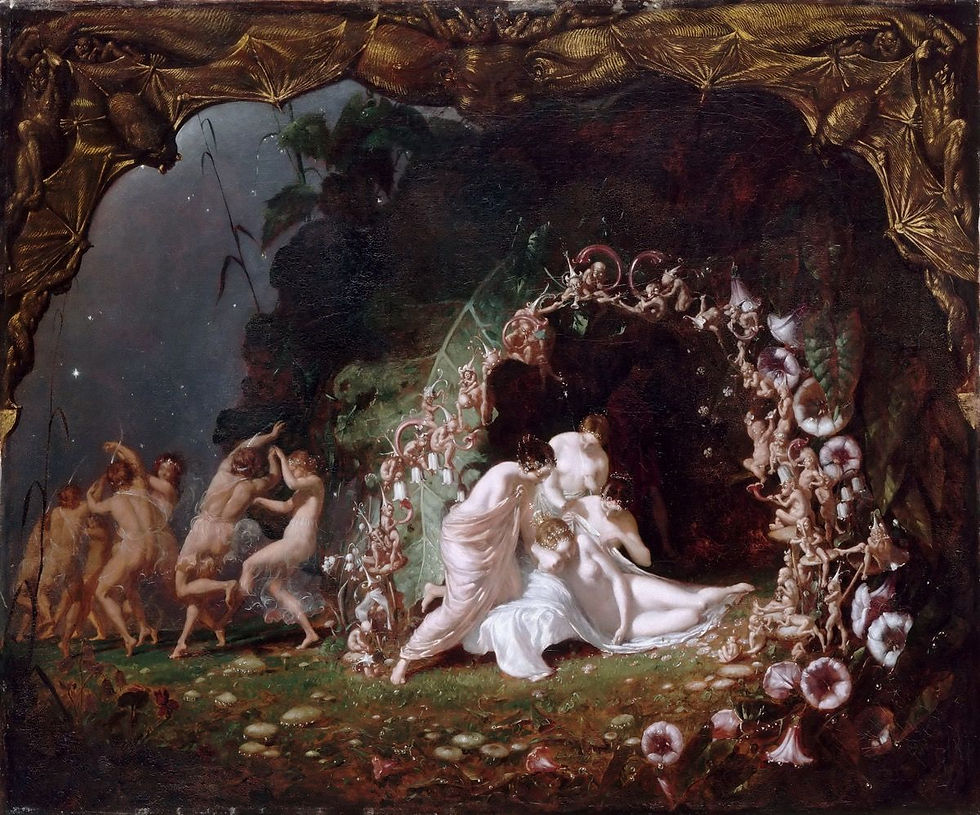Richard Dadd: The Victorian Artist Who Painted Fairy Worlds while in an Asylum
- dthholland

- May 4, 2024
- 5 min read

Richard Dadd, a Victorian artist, crafted intricate and enchanting paintings adorned with fairies and fantastical beings. Among his most renowned works is "The Fairy Feller’s Master-Stroke" (circa 1855–64), where flowers, leaves, and blades of grass cascade across the canvas, revealing a whimsical realm populated by diminutive figures clad in elaborate attire and crowns. These magical beings congregate around a brown-suited gentleman poised to split an acorn in twain with an axe.
Yet this central act of violence eerily corresponds to Dadd’s earlier misdeeds: In 1843, in a bout of madness, he killed his father, then assaulted a tourist on a train on his escape. He spent the rest of his life in institutions; the asylum became his studio, where he produced most of his imaginative paintings.
In an 1878 census from the United Kingdom, Richard Dadd was classified as both an "artist" and a "lunatic." During the Victorian era, the term "lunatic" was commonly used as a general designation for individuals dealing with mental illness. Dadd was not alone among artists and sculptors with such a label. Throughout history, scholars and doctors have explored the connection between creativity and mental health issues, a topic that even philosophers like Plato pondered in ancient Greece.
Artistic inspiration, he believed, was God-given madness. From Vincent van Gogh hacking off his own ear to Sylvia Plath’s suicide-by-oven, many of our most lauded creative practitioners are, for better or for worse, also remembered for their intense manias and depressions. Dadd offers one of the most tragic examples of inventive brilliance coupled with (poorly treated) mental illness.

Dadd's early years were rather ordinary. Born in Kent in 1817, he relocated to London with his family at the age of 18. Two years later, he began his studies at the Royal Academy. There, he formed friendships with emerging artists of his time, including Augustus Egg, William Powell Frith, and Edward Matthew Ward. Dadd garnered acclaim for his skillful draughtsmanship and devoted much of his attention to creating a series of traditional illustrations based on Shakespeare's works. By the early 1840s, he had ventured into the realm of fairy paintings, depicting characters from "A Midsummer Night’s Dream," such as Puck and Titania, the queen of the fairies. His 1842 masterpiece, "Come Unto These Yellow Sands," drew inspiration from "The Tempest." Overall, Dadd seamlessly integrated into Britain's flourishing artistic community.
“I think he was very much of his time, right up until he killed his father,” says Marc Demarest, who maintains a popular web page about Dadd. Demarest became interested in the artist after seeing The Fairy-Feller’s Master-Stroke at the Tate (where it’s in the permanent collection) in 2005. The obsessive detail, most of all, piqued his curiosity. “It’s not a painting that you can take in in 5 minutes or 15 minutes,” he said. “I still don’t know what it means. When you stand a foot and a half from it and peer into actual work, it’s pretty magical.”
The trajectory of Dadd’s life veered into a sorrowful and peculiar path during a journey across Europe and the Middle East alongside his patron, Sir Thomas Phillips. Their expedition commenced in July 1842, traversing the Alps and venturing into the enchanting city of Venice. From there, they sailed to various destinations including Greece, Constantinople (now Istanbul), Cyprus, Beirut, and Jerusalem. However, as their travels progressed, Dadd's health began to deteriorate. He started experiencing debilitating headaches, and his mental state became increasingly disturbed. In Cairo, after encountering depictions of the Egyptian god Osiris, Dadd's paranoia escalated to the point where he posed a threat to Phillips. It was reported that Dadd believed he had been chosen to combat the devil, a delusion that overshadowed the remainder of their journey.

Upon their return to London, Dadd's father escorted him to St. Luke’s Hospital for Lunatics. Despite Dadd's objections, a doctor diagnosed him as mentally ill. Subsequently, father and son journeyed to Cobham, near their family's original residence, where it's speculated that Dadd Sr. encouraged his son to seek treatment. However, instead of complying, Dadd Jr. led his father to a park, where during their evening stroll, he fatally attacked him, wielding a razor and knife. Following the gruesome incident, Dadd fled to France, assaulting a tourist en route, and then proceeded to Calais, Paris, and eventually to a town near Montereau, where authorities apprehended him. Upon searching his studio for evidence, the police stumbled upon portraits depicting acquaintances with slashed throats, indicating that Dadd had meticulously planned his murderous actions.
Even this tragic note in Dadd’s life was, in some ways, in keeping with British society’s expectations in his day. “The idea that art and madness snuggled up right next to each other—that there was something subversive, dangerous, explosive about art—was very much part of the Victorian cultural milieu,” Demarest said. Dadd’s life took the stereotype to the extreme.
British authorities sent Dadd to London’s infamous Bethlem Royal Hospital (informally known as “Bedlam”—the origin of the colloquial term). In 1864, he moved to the newly opened Broadmoor Facility, where he remained institutionalised until his death in 1886. The staff of the facility became Dadd’s patrons and occasional subjects. Portrait of a Young Man (1853), for example, is thought to depict a hospital attendant. In the painting, a man in a dark suit sits on a bench made of tangled wood; the object seems a part of nature. Victorian mental institutions were notoriously horrific. Physicians’ understanding of schizophrenia and bipolar disorder (one of which Dadd probably had) was limited at the time, and restraints and opiates served as their major tactics for calming patients. The doctors’ support for Dadd’s painting—they even helped him get supplies—is a humane note in the history of Victorian mental health care.

Fairies remained a predominant subject for Dadd throughout his life. The Fairy Feller’s Master-Stroke, which he worked on for nearly 10 years, became his magnum opus (and inspired a Queen song of the same name). His interest in the topic, notably, was not delusional, so much as it was part of a larger cultural intrigue. The British and Irish, as scholar Carole Silver writes in her 1986 book On the Origin of Fairies: Victorians, Romans, and Folk Beliefs, were trying to revive their folkloric traditions.
In his 2003 Discworld novel "The Wee Free Men," Terry Pratchett incorporates "The Fairy Feller's Master-Stroke" by Richard Dadd. The protagonist, Tiffany, discovers the painting within a book of fairy tales and subsequently finds herself trapped within a dream depicted in the artwork. In an author's note, Pratchett offers a description of the painting and provides a compassionate overview of Dadd's life, acknowledging his personal challenges and battle with mental illness.
Romantic poets like Percy Bysshe Shelley and Samuel Taylor Coleridge wrote about sprites in the early 19th century; their fantastical works fueled the Victorian imagination.
“Though the Romantic spirit hatched the fairies,” Silver writes, “it was the Victorian passion for investigation that nourished them.” Ideas about psychology and the unconscious were emerging, while the dawning Industrial Revolution encouraged the use of science and technology for new discoveries. Fairy mania eventually reached its peak in the early 20th century, when young girls convinced Sherlock Holmes writer Sir Arthur Conan Doyle that they’d managed to photograph fairies; in 1920, he included the pictures in a magazine article on the theme, and the story became a media sensation.
Dadd transformed a mad cultural obsession into transfixing artwork. “The artist’s illness is unquestionable and so, I think, is his peculiar genius,” Jonathan Jones wrote in a Guardian review of a 2015 exhibition of Dadd’s work. But he notes that in Dadd’s case, his mental illness may not have been connected to his art. “This is just one extraordinary case.…Dadd’s life was desolate. The art he made from it, in flight from it, is a joy.”
Dadd died on 7 January 1886, "from an extensive disease of the lungs". A "substantial number" of his works are on display in the Bethlem Royal Hospital Museum





































































































